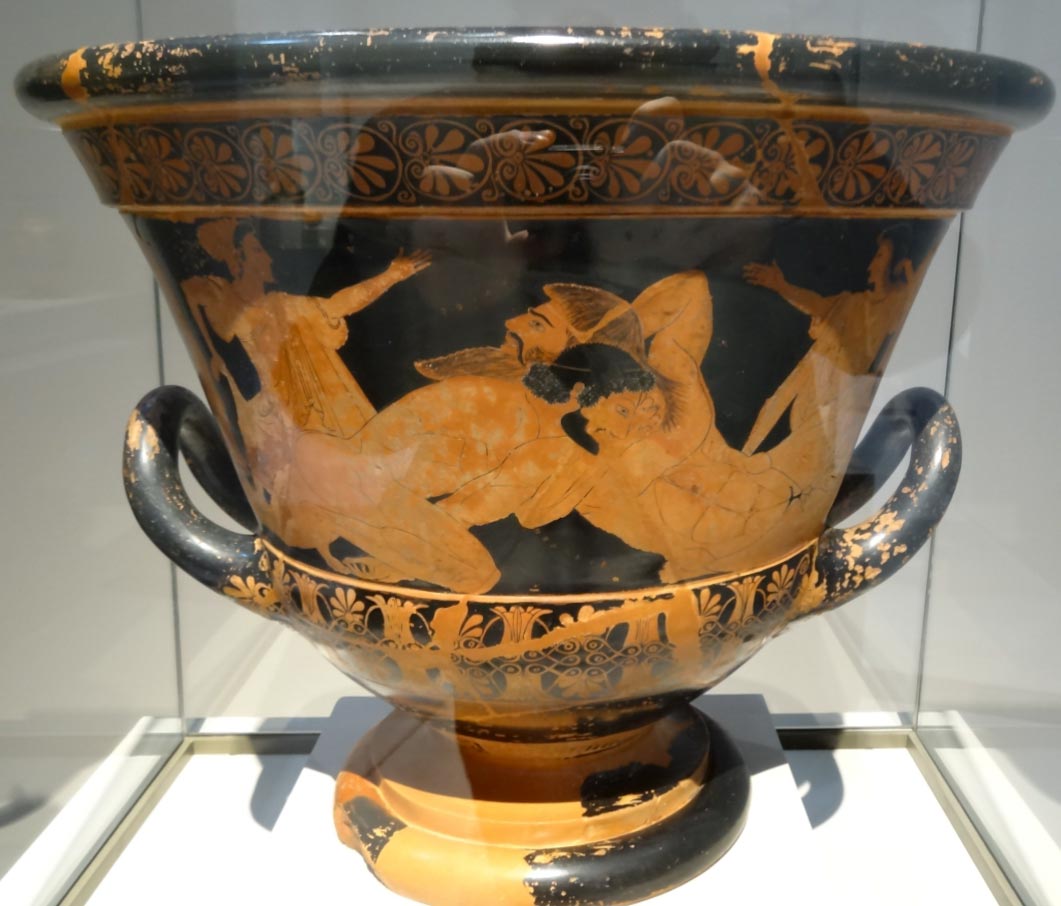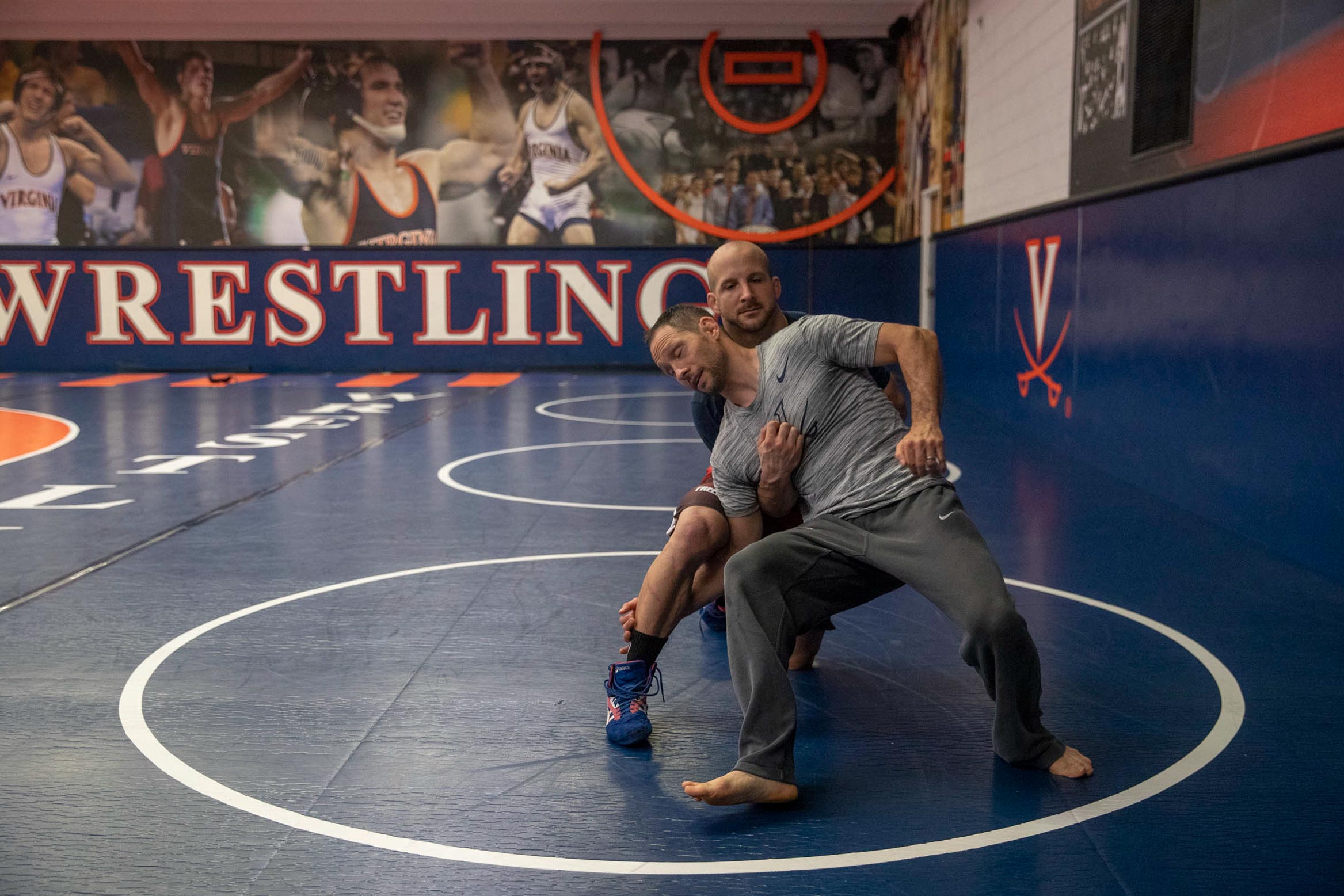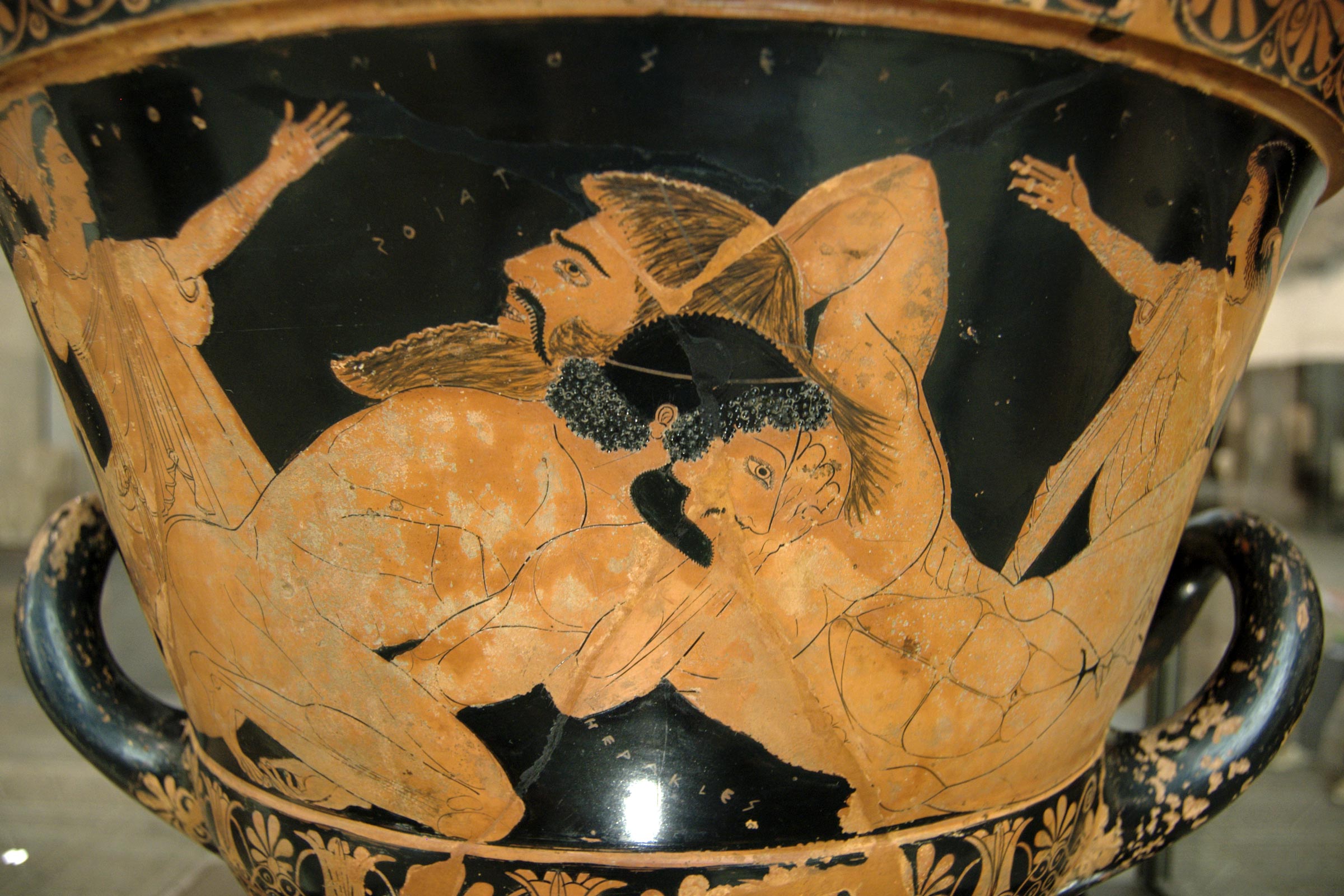Tag Team: UVA Art Professor and Wrestling Coach Tackle Ancient Mystery
On a recent weekday in Onesty Hall, University of Virginia classical archaeologist John Dobbins, UVA head wrestling coach Steve Garland …
On a recent weekday in Onesty Hall, University of Virginia classical archaeologist John Dobbins, UVA head wrestling coach Steve Garland and assistant coach Trent Paulson exchanged a few pleasantries, then took off their shoes and stepped onto a wrestling mat.
Their objective: to try and solve a mystery surrounding an ancient Greek vase residing in the Louvre museum in Paris.
For Dobbins, the mystery was years in the making.
For Garland, the mystery – at least, initially – was why a classical archaeologist required a wrestling coach’s expertise.
“‘Surprised’ would be an understatement,” said Garland, recalling his first interaction with Dobbins.
While in graduate school, and for the better part of a 40-year teaching career at UVA, Dobbins had wondered about a mythological wrestling scene painted by the renowned vase painter Euphronios that dated back to 510 BCE.
 This ancient vase is considered a textbook example of Greek vase painting. (Photo by Jérémy-Günther-Heinz Jähnick)
This ancient vase is considered a textbook example of Greek vase painting. (Photo by Jérémy-Günther-Heinz Jähnick)
Are the two wrestlers, Greek hero Herakles and the Libyan earth-giant Antaios, engaged in a real wrestling move, pertaining to the myth in which Herakles attempts his 11th labor?
“A special property of Antaios was that his strength increased when he was in contact with his mother, Earth – a useful benefit for a wrestler!” Dobbins said. “The only way that Herakles could win was to lift Antaios and crush him as his strength drained.”
At Onesty Hall, Garland and Paulson tried to give Dobbins his answer.
With Dobbins observing and occasionally directing a sparring session, the duo – with Paulson in the role of Herakles and Garland as Antaios – attempted to replicate the move.
The final verdict?
“They have identified the under hook, a hold that is preparatory to a lift,” Dobbins explained afterward. “Herakles slips his right arm under the right arm of his opponent and extends it along his chest. The left arm of Herakles is behind the back of Antaios and we can’t see it. If Herakles is successful, his left arm will come across Antaios’s chest and Herakles will be able to lift the giant. Antaios knows what is happening and he reaches back to grab the left hand of Herakles.”
 UVA head wrestling coach Steve Garland (gray shirt) and assistant Trent Paulson attempt to replicate the wrestling moves of Greek hero Herakles and Libyan earth-giant Antaios. (Photo by Sanjay Suchak, University Communications)
UVA head wrestling coach Steve Garland (gray shirt) and assistant Trent Paulson attempt to replicate the wrestling moves of Greek hero Herakles and Libyan earth-giant Antaios. (Photo by Sanjay Suchak, University Communications)
 The vase, painted by the ancient Greek vase painter and potter Euphronios, is currently on display at the Louvre museum in Paris.
The vase, painted by the ancient Greek vase painter and potter Euphronios, is currently on display at the Louvre museum in Paris.
“Euphronios has captured a moment of dramatic tension when the under hook is in progress. If Herakles fails, Antaios will kill him. Every viewer knew that Herakles would win, but at this moment the outcome is uncertain. This is high drama. Far from presenting generic wrestling, Euphronios has selected the key moment in the bout.”
Garland and Paulson sure seemed to have a good time.
“We had to try and piece it together by feeling it and saying, ‘What would they be doing in that picture there?’” said a smiling Garland, pointing to a paper printout of the vase. “The hard thing to interpret is what would happen next, because there are so many positions that can come out of it. There are endless possibilities. But after going through the motions, I feel like we nailed it there at the end.”
In the actual image, the head of Antaios is twisted in a way that is anatomically impossible – an example of artistic license, according to Dobbins.
“This was a period in Greek vase painting in which artists were trying to work out various aspects about the human body – such as correct anatomical depiction and the human body standing, lunging and reclining,” he said. “They wanted to show that they had the skill to present the body in profile, frontally and turning
“And so that’s what Euphronios is doing. He’s positioned Herakles, so that his profile would be shown and can see how the body moves in that position. And then Antaios, the earth giant, is shown from the front – so that he can say, ‘I know how to draw the human torso from the front.’ I think the head is presented that way simply to allow him to show both heads in profile because the human body can’t twist the head in that fashion.”
Both Dobbins and Garland said they enjoyed the opportunity to learn about each other’s work.
Dobbins believes he and Garland have revealed new dimensions to the Euphronios masterpiece.
“Not only did Euphronios know how to wrestle, but he also knew how to tell a good story by highlighting its most dramatic moment,” Dobbins said. “Euphronios was an innovator. This vase anticipates works of Greek art that depict similar dramatic moments, perhaps culminating in the Athenian dramas of Aeschylus.”
In January, Dobbins will present a paper on the subject, “Euphronios Knew How to Wrestle,” at the Archaeological Institute of America’s annual meeting in San Diego.
“The paper represents a very fruitful engagement between Coach Garland and myself,” Dobbins said.
Whitelaw Reid
University News Associate
Office of University Communications
Original Publication: UVA Today
You are using an old version of Internet Explorer. Our site is developed with the latest technology, which is not supported by older browsers
We recommend that you use Google Chrome for accessing our (or any) website. It is a FREE and modern web-browser which supports the latest web technologies offering you a cleaner and more secure browsing experience.